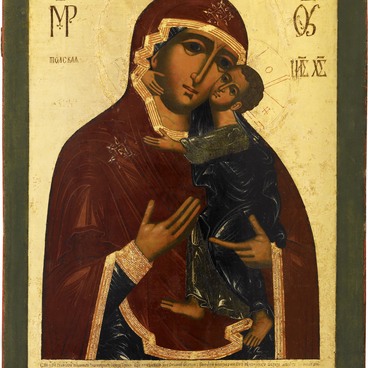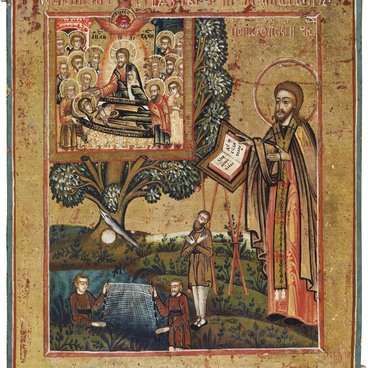The icon ‘Our Lady of Tikhvin’ from the collection of the Rybinsk Museum belongs to the category of small and quickly painted palm-sized icons that were created specifically for pilgrims. The icon ‘Our Lady of Tikhvin’ was painted in 1897, presumably in the Gethsemane monastery in Sergiev Posad. Venerable Barnabas blessed with this icon Count Alexander Alexeyevich Ukhtomsky, a native of the Rybinsk district, who shortly before that took monastic vows with the name of Andrey.This is evidenced by the inscription on the back of the icon.
The icon belongs to the type of Hodegetria (Guide). The name comes from the ancient Christian temple of Hodegon in Greece, where the first icon of this type was discovered. Icons of this type usually portrayed the Virgin Mary waist-high, holding the Jesus Child in her arms. According to the legend, a version of this icon appeared before the believers on a bank of Tikhvinka river in the Novgorod region back in the 14th century, so it became to be called ‘Our Lady of Tikhvin’. The legs of the Divine Child are bent at the knees, with the right foot being behind the left. Jesus holds a scroll in one hand, and the other hand is raised in a blessing gesture.
The icon belongs to the type of Hodegetria (Guide). The name comes from the ancient Christian temple of Hodegon in Greece, where the first icon of this type was discovered. Icons of this type usually portrayed the Virgin Mary waist-high, holding the Jesus Child in her arms. According to the legend, a version of this icon appeared before the believers on a bank of Tikhvinka river in the Novgorod region back in the 14th century, so it became to be called ‘Our Lady of Tikhvin’. The legs of the Divine Child are bent at the knees, with the right foot being behind the left. Jesus holds a scroll in one hand, and the other hand is raised in a blessing gesture.

